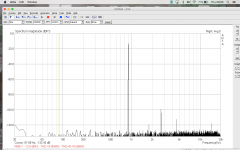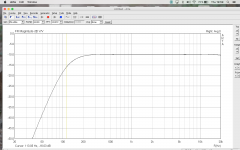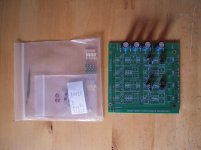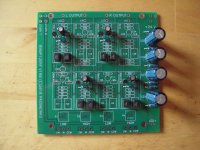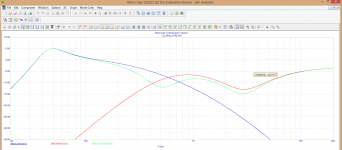MagicLX521,
I have been waiting for the LX Mini+2 ASP, but haven’t seen any mention of your ASP circuit by Nelson Pass, at the First Watt website, at Madisound (the US supplier for LXMini drivers), on the diyaudiostore, or at Hairball audio (the US source for Sigfried Linkwitz’s LX521.4 ASP)...is this your own adaptation of the Nelson Pass LXMini+2 design?
I use these speakers as studio monitors for mixing audio and would prefer an ASP to the MiniDSP 4x10, but without any documentation for your product, it is hard to know exactly what one is getting. Can you provide more information?
—Mark
I have been waiting for the LX Mini+2 ASP, but haven’t seen any mention of your ASP circuit by Nelson Pass, at the First Watt website, at Madisound (the US supplier for LXMini drivers), on the diyaudiostore, or at Hairball audio (the US source for Sigfried Linkwitz’s LX521.4 ASP)...is this your own adaptation of the Nelson Pass LXMini+2 design?
I use these speakers as studio monitors for mixing audio and would prefer an ASP to the MiniDSP 4x10, but without any documentation for your product, it is hard to know exactly what one is getting. Can you provide more information?
—Mark
Crossover measurements
Two pics showing the crossover used as a 24 dB/octave high-pass filter
Distorsion at 1 V rms out and frequency response with cross-over at around 115 Hz (Quad ESL57 + and LX521 dipole bass combo)
Maybe not as good as using Toshiba parts but very respectable hi-end numbers.
SQ is wonderful.
I'm happy
Two pics showing the crossover used as a 24 dB/octave high-pass filter
Distorsion at 1 V rms out and frequency response with cross-over at around 115 Hz (Quad ESL57 + and LX521 dipole bass combo)
Maybe not as good as using Toshiba parts but very respectable hi-end numbers.
SQ is wonderful.
I'm happy
Attachments
I'm happy
Your .003% is about as good as you will get with the Fairchild parts. The
Toshibas can manage .001%.
I have been waiting for the LX Mini+2 ASP, but haven’t seen any mention of your ASP circuit by Nelson Pass, at the First Watt website, at Madisound (the US supplier for LXMini drivers), on the diyaudiostore, or at Hairball audio (the US source for Sigfried Linkwitz’s LX521.4 ASP)...is this your own adaptation of the Nelson Pass LXMini+2 design?
I am providing the kit and finished boards for this. At the moment, I have
a production piece on the bench, and I'm just adjusting the gain figures,
and then I will populate some for delivery in a week or so.
PASS AXO starting my build
I wish you all a welcome on the forum and always enough voltage and current in your projects!
I have started my crossover build in a different way. I don't want to use it for the LXmini.
I will use it as a 2-way-crossoverin my own speaker build. (crossover frequency will be around 2500Hz).
I am thinking to use the bandpass on the board (LOW output) between
80Hz and 2500Hz. I will make this switchable between the two filterpoles.
Gives me the possibility to add a subwoofer later.HIGH output will be used
above 2500Hz without the equalization network.
But I am at the beginning of this `journey`. Greetings from Germany
Dirk
I wish you all a welcome on the forum and always enough voltage and current in your projects!
I have started my crossover build in a different way. I don't want to use it for the LXmini.
I will use it as a 2-way-crossoverin my own speaker build. (crossover frequency will be around 2500Hz).
I am thinking to use the bandpass on the board (LOW output) between
80Hz and 2500Hz. I will make this switchable between the two filterpoles.
Gives me the possibility to add a subwoofer later.HIGH output will be used
above 2500Hz without the equalization network.
But I am at the beginning of this `journey`. Greetings from Germany
Dirk
Attachments
Last edited by a moderator:
Could the board be fed with +/- 12V supply instead of the 24V, since I already have some of the parts to do that? Anything special that would need to be done?
The board has a midpoint voltage reference for biasing the Fets, and
ground is what you might think of as the negative rail.
If you're not using that supply elsewhere and the ground is isolated
then you can drive the board with the -12V being ground and +12 forming
the positive rail. The ground of the power supply is best left unattached.
Hello Papa and all,
I am new and just begin the kit, will using it for a full range and Alpha 15a OB,
have downloaded the micro-cap but the file link cannot open, please help!
Thanks a lot,
Owen
There are plans for a more general crossover.
The LXmini crossover can be stuffed for a variety of loudspeakers.
You have the board and existing schematic, and I have posted a
MicroCap sim file:
404 Not Found for you to play with.
I am new and just begin the kit, will using it for a full range and Alpha 15a OB,
have downloaded the micro-cap but the file link cannot open, please help!
Thanks a lot,
Owen
There are plans for a more general crossover.
The LXmini crossover can be stuffed for a variety of loudspeakers.
You have the board and existing schematic, and I have posted a
MicroCap sim file:
404 Not Found for you to play with.
Last edited by a moderator:
I am providing the kit and finished boards for this. At the moment, I have
a production piece on the bench, and I'm just adjusting the gain figures,
and then I will populate some for delivery in a week or so.
Great news and thank you for the reply. Can they be used for unbalanced as well as unbalanced connections? (I would use this balanced in from my DAC but the amps are unbalanced).
And only for sale through MagicLX521? If so, I get the business relationships involved...I guess it will make me smile to think that those parts made two trips across the Atlantic as I am soldering them in...
With best regards,
Mark
have download the micro-cap but the file link cannot open, please help!
Technical issue, working on it...
Great news and thank you for the reply. Can they be used for unbalanced as well as unbalanced connections? (I would use this balanced in from my DAC but the amps are unbalanced).
And only for sale through MagicLX521? If so, I get the business relationships involved...I guess it will make me smile to think that those parts made two trips across the Atlantic as I am soldering them in...
You can easily operate a stereo single ended crossover like this as mono
crossover balanced.
The MagicLX521 does the conversion with extra circuitry and also offers
both LXmini and also the two subwoofer versions, which makes for a
large circuit board.
I am informed that a board + fets kit will be offered by him as well.
Down the road, probably a similar but more basic kit will be offered
through the store.
Hello and thanks for the immediate response.
Rereading the pdf document better there is the possibility of lowering the values,
sorry but I had escaped. I have 2.2mf polypropylene capacitors, can they fit?
I changed the values on Spice for a dipole with 1 largabanda of about 150hz up in the high street and a woofer in the low street, I would like to please his opinion on these new filter values.
Thank you so much and excuse my low level of technical preparation
Rereading the pdf document better there is the possibility of lowering the values,
sorry but I had escaped. I have 2.2mf polypropylene capacitors, can they fit?
I changed the values on Spice for a dipole with 1 largabanda of about 150hz up in the high street and a woofer in the low street, I would like to please his opinion on these new filter values.
Thank you so much and excuse my low level of technical preparation
Attachments
Last edited by a moderator:
Hello,
I would need help obtaining a resulting trace from the FW miniLX micro-cap simulation. A cumulated response to be more precise.
To the best of my knowledge and from the LTspice simulation experience of my speakers passive filters, I added DB function to the sum of the resulting voltages or the logarithm of the resulting voltage amplitudes (that giving the form of the resulting equalizing curve to the best of my knowledge).
micro-cap simulation resulting cummulated response attached:
The question is :
Is this the equivalent of the sum of the resulting SPL if the amplifier would drive perfect ideal restive loads?
I would need help obtaining a resulting trace from the FW miniLX micro-cap simulation. A cumulated response to be more precise.
To the best of my knowledge and from the LTspice simulation experience of my speakers passive filters, I added DB function to the sum of the resulting voltages or the logarithm of the resulting voltage amplitudes (that giving the form of the resulting equalizing curve to the best of my knowledge).
micro-cap simulation resulting cummulated response attached:
The question is :
Is this the equivalent of the sum of the resulting SPL if the amplifier would drive perfect ideal restive loads?
Attachments
- Home
- Amplifiers
- Pass Labs
- LX-mini Crossover Article
